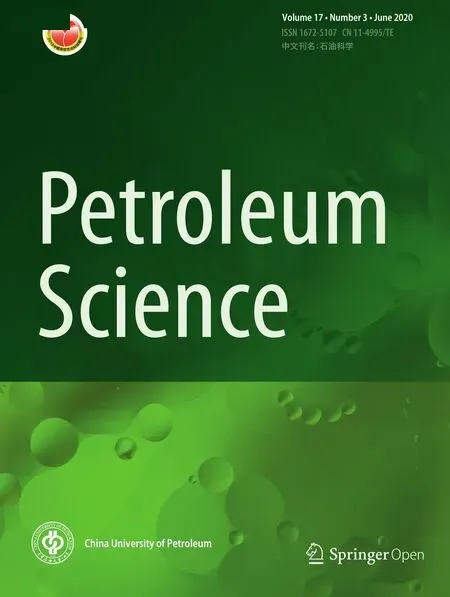Evaluating the potential of surface‑modi fied silica nanoparticles using internal ole fin sulfonate for enhanced oil recovery
Afaque Ahmed · Ismail Mohd Saaid · Abdelazim Abbas Ahmed · Rashidah M. Pilus · Mirza Khurram Baig
Abstract Recently, nanoparticles have proven to enhance oil recovery on the core- flood scale in challenging high-pressure high-temperature reservoirs. Nanomaterials generally appear to improve oil production through wettability alteration and reduction in interfacial tension between oil and water phases. Besides, they are environmentally friendly and cost-effective enhanced oil recovery techniques. Studying the rheological properties of nanoparticles is critical for field applications. The instability of nanoparticle dispersion due to aggregation is considered as an unfavorable phenomenon in nano fluid flooding while conducting an EOR process. In this study, wettability behavior and rheological properties of surface-treated silica nanoparticles using internal ole fins sulfonates (IOS20–24 and IOS19–23), anionic surfactants were investigated. Surface modi fication effect on the stability of the colloidal solution in porous media and oil recovery was inspected. The rheology of pure and surfacetreated silica nanoparticles was investigated using a HPHT rheometer. Morphology and particle size distributions of pure and coated silica nanoparticles were studied using a field emission scanning electron microscope. A series of core- flood runs was conducted to evaluate the oil recovery factor. The coated silica nanoparticles were found to alter rheological properties and exhibited a shear-thinning behavior as the stability of the coated silica nanoparticles could be improved considerably.At low shear rates, the viscosity slightly increases, and the opposite happens at higher shear rates. Furthermore, the surfacemodi fied silica nanoparticles were found to alter the wettability of the aqueous phase into strongly water-wet by changing the contact angle from 80° to 3° measured against glass slides representing sandstone rocks. Oil–water IFT results showed that the surface treatment by surfactant lowered the oil–water IFT by 30%. Also, the viscosity of brine increased from 0.001 to 0.008 Pa s by introducing SiO2 nanoparticles to the aqueous phase for better displacement efficiency during chemicalassisted EOR. The core- flood experiments revealed that the ultimate oil recovery is increased by approximately 13% with a surfactant-coated silica nano fluid flood after the conventional water flooding that proves the potential of smart nano fluids for enhancing oil recovery. The experimental results imply that the use of surfactant-coated nanoparticles in tertiary oil recovery could facilitate the displacement efficiency, alter the wettability toward more water-wet and avoid viscous fingering for stable flood front and additional oil recovery.
Keywords Silica nanoparticles · Anionic surfactant · Rheological properties of nano fluids · Wettability alteration ·Enhanced oil recovery
1 Introduction
The decrease in the production rate in existing oil fields triggers concerns on enhancing the oil recovery factor. Most of the fields with residual oil saturation above thirty-percent are being abandoned (Zhang et al. 2008). Additional revenue can be achieved with a minor percent increase in the ultimate recovery factor. To attain the increasing oil recovery over the secondary baseline, the tertiary oil recovery technique has been designed (Kong and Ohadi 2010; Green and Willhite 1998). The residual oil after water flooding is indispensable and cannot be ignored particularly in the present situation of high energy demand. Further increase in oil recovery can be done after water flooding by utilizing various enhanced oil recovery (EOR) techniques (Maugeri 2009; Liebum et al.2018). The decline in primary production of oil using conventional recovery approaches led to several developed techniques for EOR before the reservoir is abandoned. Recent studies of nanoparticles in EOR have offered hope to forthcoming EOR methods. Among them, silica nanoparticles are considered extensively (Ebrahim et al. 2019; Evdokimov et al. 2006; Hendraningrat et al. 2013; Roustaei et al. 2013).Various nano fluids could be prepared by dispersing them in different base- fluids (Sharma and Sangwai 2017; So fla et al. 2019).
In view of declining production from oil fields and a time when recovering hydrocarbons are becoming more diffi-cult, effective techniques are key to extract more oil from mature fields. In addition to the advent of nanotechnology,nanoparticles have emerged as promising materials to further improve various EOR techniques. Nanoparticles with at least a single dimension of 1–100 nm make them pass through porous media with relative ease. They are environmentally friendly especially in challenging temperature and pressure reservoirs (Lau et al. 2017; Olajire 2014; Singh and Mohanty 2014). When nanoparticles are introduced into the subsurface, they may create or break emulsions, or they may alter the porous media wettability (Romero-Zerón 2012;ShamsiJazeyi et al. 2014), thereby enhancing oil recovery.Surfactant flooding, on the other hand, has limitations as surfactants cannot be stabilized for long periods of time,especially in the presence of oil, high temperature and high salinity. The robustness of the surfactant can be increased signi ficantly by the addition of surface-modi fied nanoparticles (Emrani et al. 2017; Singh and Mohanty 2014). Studying the rheological properties of nanoparticles is critical for field applications. An extensive distribution of nanoparticles indicates that the nanoparticles have enough speci fic surface area to transport around, which eventually causes a reduction in viscosity in case they are stable and not agglomerated (Ahmed et al. 2018a, b). Shear stress is a key indicator of categorizing Newtonian and non-Newtonian nano fluids(Ahmed et al. 2018a, b; Sharma and Sangwai 2017). Increasing the shear rate causes weaker particle–particle interactions to break hence causing nano fluids behaving like a Newtonian fluid (Hadadian et al. 2013). The viscosity of the nano fluid is not directly affected by particle aggregation.Nonetheless, with the small-scale accumulation of nanoparticles, the actual volume fraction becomes much lower than the effective volume fraction and as a result, nano fluids’ viscosity rises (Mishra et al. 2014; Rezaei et al. 2016).Apparently, the temperature has an absolute correlation with viscosity. Overall results revealed that with increasing temperature, a regular descending viscosity trend was observed.That suggests that viscosity reduces as the temperature rises,due to a reduction in inter-molecular forces among particles and the base- fluid (Thomas and Sobhan 2011).
Having considered the potential of silica nanoparticles in enhancing oil recovery, the performance evaluation of anionic surfactant-coated silica nanoparticles was evaluated.Although nanoparticles have widely been studied for EOR applications, however, a smart nano fluid like silica nanoparticles coated with anionic surfactant could be an emerging class of material that is superior to conventional nanoparticles. Anionic surfactant-coated silica nanoparticles may force injected fluid to move through the smaller pores by occupying high permeable zones and make the permeability uniform throughout the medium (Agi et al. 2018). It is known that the surfactant helps to improve the oil recovery by working at a microscopic level such that at the oil/water interface while nanoparticles being worked at a macroscopic level improves the overall displacement efficiency of the injected fluid (Emrani et al. 2017; Farid Ibrahim and Nasr-el-Din 2018). Hence, it is suggested that if both the surfactant and nanoparticles are used together, then the mobility ratio can relatively be much improved and less quantity of chemical (surfactant) will be required to accomplish the task of improving oil recovery from the depleted reservoirs because of the silica nanoparticles presence in the injected fluid.
Additionally, nanoparticles are assumed to reduce the effort of deformation required for an oil droplet to get displaced through the pore throat and help in mobilizing oil easily and effectively. Nanoparticles adsorb along with the interface of oil and water so as to reduce the IFT between oil/water and alter the wettability toward more water-wet(Romero-Zerón 2012; Souayeh et al. 2018). Moreover, the process of adsorption occurred between the nanoparticle and the surfactant on the rock surface and the surfactant doublelayer formation together contributes to altering rock wettability (Souayeh et al. 2018). Conversely, the presence of nanoparticles in the aqueous phase also increases the injected fluid viscosity (Franco-Auguirre et al. 2018; Maestro et al.2012). The increase in viscosity along with the IFT reduction and wettability alteration causes changes in the viscous and capillary forces; thus, increasing capillary numbers that ultimately could improve the oil recovery (Emadi et al. 2017;Manshad et al. 2017; Rezvani et al. 2018).
Although a lot of work has been done on the surface treatment of silica nanoparticles, no work related to ole fin-based anionic surfactants for application in enhanced oil recovery has been reported yet according to the best of our knowledge. Hence, a detailed investigation is required to explore the newly developed ole fin-based silica nanoparticles for EOR. The aim of this paper is to investigate the potential application of nano fluids in IOR/EOR processes. Silica nanoparticles were selected for the study, as they comprise more than 99% SiO2, which is the main constituent of sandstone rocks. Moreover, SiO2is an environmentally friendly chemical. Additionally, these inorganic silica nanoparticles can be employed easily with regard to physical–chemistry properties (Miranda et al. 2012). In this work, the wettability and rheological properties of surface-treated silica nanoparticles using internal ole fins sulfonates (IOS20–24and IOS19–23), anionic surfactants have been investigated. For this, an HPHT rheometer was used to investigate the rheological properties before and after surfactant treatment. Finally, a coreflood experiment with the help of the Formation Evaluation System (FES-350) was conducted to con firm the potential of developed smart nano fluid in increasing ultimate oil recovery.
2 Materials and methods
Silica nanoparticles, trade name AEROSIL(R)OX 50, utilized in this study were provided by Evonik Malaysia Sdn Bhd. The nanoparticles had a typical silica-content more than 99% and an average size of 20–30 nm, speci fic surface area of 48 m2/g and 4.3 pH value. Two commercially used internal ole fin sulfonates (IOS), i.e., ENORDET™O-242 (IOS20–24)–Surf X and ENORDETTMO-342(IOS19–23)–Surf Y, were provided by Shell Chemicals. Surf X contains 20 to 24 carbon atoms with a sulfonate group attached to their head, while Surf Y consists of 19 to 23 carbon atoms and a sulfonate group attached to it. The densities of these two IOS surfactants Surf X and Surf Y are 0.9986 and 0.9987 g/cm3, respectively. The only difference found between them is the length of the carbon chain. Both surfactants are applicable for low/medium salinity and are thermally stable up to reservoir conditions of 200 °C. On their own, IOS has limited aqueous solubility, particularly in brines containing higher levels of Ca2+and Mg2+ions(‘hard’ brines).
A degassed Malaysian crude oil used in this study had an API density of approximately 40.2° at standard temperature and a viscosity of 3.53 cP. The crude oil used was free from any type of additives and was filtered prior to being used for experiments so as to ensure the consistency of the crude oil components. Sodium chloride (3.5% NaCl, supplied by Sigma-Aldrich) was used to prepare brine of salinity of 35,000 ppm in accordance with the salinity of seawater used in Malaysian reservoirs.

Fig. 1 Process flow of surface modi fication of silica nanoparticles
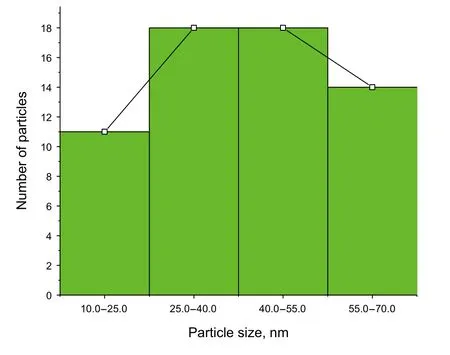
Fig. 2 Size distribution of silica nanoparticles
2.1 Surface activation of silica nanoparticles
For the surface modi fication, 20 g of pure silica nanoparticles was mixed with 200 mL of 2 wt% prepared surfactant solutions for approximately 48 h at 50 °C. The modi fied particles were separated from the mixture using a Heraeus MULTIFUGE X1R Centrifuge at approximately 8000 rpm for 20 min. Later, the prepared samples were washed with distilled water and filtered repeatedly so that the untreated silica nanoparticles were washed out. Lastly, the treated silica nanoparticles were placed in a laboratory oven at 50 °C for 72 h to get dried. The process flow is demonstrated in Fig. 1 (van der Merwe et al. 2011).
The size of silica nanoparticles derived from SEM images was 40 ± 6.2 nm (nanoparticle number = 100), and their associated size distributions are shown in Fig. 2. The particles were dispersed in ethanol and ultra-sonicated to remove agglomeration. After TEM analysis, the particle diameter for 100 particles was calculated. The size distribution shows that the average size was around 40 nm. The wettability of treated and untreated particles is controlled with the help of an extensive balance of hydrophobic and electrostatic interactions among the particle surface and the surfactant. These interactions play an important role in the structure of the surfactant–particle nanocomposite interfacial layer (Maestro et al. 2012).
2.2 Effect of surface treatment on the morphology of silica nanoparticles
Figures 3, 4 and 5 illustrate the field emission scanning electron microscopy (FESEM) images of silica nanoparticles before and after IOS treatments. These images suggest that the silica nanoparticles were coated with surfactants. The presence of the surfactant layers absorbed on silica nanoparticles would reduce the attractive forces between the particles and provided signi ficant dispersion stability in the aqueous phase as the particles were found to be agglomerated before the modi fication. It was also noted that silica particles were of nano-size (averaging 90 nm). This ultrasmall size can overcome the challenge of pore plugging in porous media as particles can easily pass through the pore throats without severe permeability reduction. This ability can allow nanoparticles to have more contact with swept zones thus increasing the macroscopic sweep efficiency and then the effectiveness of injected fluids for EOR.
Figure 3 shows the results of FESEM with 30 K magnification for untreated silica nanoparticles in which agglomeration of particles was observed due to strong attractive forces among them. Under the same magni fication, when the surface of silica nanoparticles was modified (see Figs. 4 and 5), the attraction forces between the particles were found to be reduced as the particles were seemed to be relatively more dispersed after treatment.
Characterization suggested that after treatment the nanoparticles possess high surface energies because of high ratio of surface to volume along with van der Waals attraction or magnetic attractions, while there is insufficient repulsion (e.g., electrostatic or con figurational entropic)between the particles that leads them to form a secondary shape that is relatively large than their primary size(Nandanwar et al. 2011).

Fig. 3 Morphology of pure silica nanoparticles using FESEM (magni fication = 30 K times)

Fig. 4 Morphology of Surf X-coated silica nanoparticles using FESEM (magni fication = 30 K times)

Fig. 5 Morphology of Surf Y-coated silica nanoparticles using FESEM (magni fication = 30 K times)
2.3 Wettability analysis
Contact angles were directly measured on glass slices representing sandstone rock using IFT-700 (IFT pendant drop)equipment at room conditions before and after surface treatment. The contact angle is one of the most commonly considered methods to estimate the wetting characteristic of rocks and is de fined as “the angle formed at the boundary surface by a liquid with solid and is measured through the liquid to solid” (Singh and Mohanty 2016). The contact angle expresses the tendency of a liquid to get adhered to the solid surface in the presence of another immiscible liquid.Low contact angle shows stronger wetting characteristic, i.e.,0° is completely wetting and 180° completely non-wetting.The system of measurement consists of rock/glass surface,oil and nano fluids/brine.
2.4 Rheological property measurements
In EOR applications, mobility ratio is one of the most important parameters and can be de fined as the ratio between the mobility of the displacing fluid to the mobility of the displaced fluid (Liebum et al. 2018). In flooding cases, the displacing fluid is then injected (nano fluid) and the displaced one is the residual oil present inside the core. The shear rate always affects the viscosity whenever the fluid is injected into the porous media. Therefore, the displacing phase viscosity is a very important factor in deploying nano fluid in
porous media. Therefore, rheological properties were evaluated with an HPHT Modular Compact Rheometer (MCR 302). Measurements were taken at ambient temperature with the help of DG 26.7 double-gap geometry. Before taking measurements, samples were set to equilibrate at the desired temperature for approximately 10 min.
2.5 Core‑ flood experimental setup
A Formation Evaluation System (FES 350) supported by Vinci Technologies was used to conduct core- flood experiments. FES 350 has the capability to inject multiple fluids with maximum pore pressure up to 5000 psi, con fining pressure up to 10,000 psi and temperature up to 200 °C. Figure 6 shows a schematic diagram of the core- flood setup.
2.6 Core preparation
For all the core- flood experiments, two buff Berea sandstone cores (3″ length and 1.5″ diameter) were used. These experiments were aimed to reveal the capability of surface-modified nano fluids for EOR applications. Different core properties including porosity and permeability were measured in the core laboratory using Poroperm COVAL 30. After the measurements of core properties, each core was first placed in a beaker containing distilled water and the air was evacuated from the chamber using a vacuum desiccator that allows water to enter the core easily.

Fig. 6 Experimental setup of a Formation Evaluation System (FES-350)
Table 1 summarizes the physical parameters of cores obtained from Poroperm COVAL 30.
The experimental procedure used for core flooding is as follows:
(1) The water-saturated core was mounted in the core holder and then flooded with brine to ensure full-core brine saturation at given temperature–pressure conditions. The injection rate and the con fining pressures were 0.2 mL/min and around 3000 psi, respectively.
(2) The brine-saturated core was flooded with crude oil to establish initial water saturation (Swi) at a flow rate of 0.2 mL/min until no more brine was produced. In order to reach that situation, nearly 2 PV (pore volume) was required.
(3) Brine (approximately 2 PV) was then injected into the oil-saturated core at a flow rate of 0.2 mL/min until no more oil was produced. The residual oil saturation after water production was termedSor.
(4) After water flooding, nano fluid injection (2 PV) at a rate of 0.2 mL/min was started as a tertiary recovery technique. The nano fluid concentration was kept 0.1 wt%on the basis of earlier screening. The decreased residual oil saturation along with the ultimate oil recovery was evaluated for two cases: pure silica nano fluid flooding and flooding with surfactant-coated silica nano fluid.
(5) The last step followed was a 2 PV post-water flood at a flow rate of 0.2 mL/min.
3 Results and discussion
3.1 Contact angles
For measuring contact angle, 0.05 wt% and 0.10 wt% of nanofluids were chosen. The sessile and pendant drop method (IFT-700 tensiometer, France) was used to measure the contact angle of pure and surface-modi fied silica nanoparticles in the liquid/liquid system. The contact angle was measured on nano fluids-treated glass slides representing sandstone samples. The glass was first cleaned with methanol followed by distilled water. Each oil drop was made at the different locations of the glass slide at similar conditions.
The contact angle of the initial oil drop over the glass slice was observed to be 80° (average of left and right angles). Having dispersed the glass piece separately at room temperature into different concentration nano fluids with the aging time of approximately 48 h followed by drying in a heated oven for 24 h, the reduction in contact angle was found in the presence of silica nano fluids (see Fig. 7). On repeating the measurements several times, similar results were observed with the tolerance of ± 3 degrees of contact angle.

Table 1 Physical parameters of cores

Fig. 7 Oil drop images over glass after being treated with brine (a) and silica nano fluid (b) using the sessile and pendant drop method
In addition, the contact angles of surfactant-coated silica nano fluids (Surf Y- and Surf X-coated silica nano fluids) with oil drop were observed to decline in comparison with when it was initially measured with brine, as shown in Fig. 8,which represents the contact angle measurements of crude oil and brine/nano fluids at various concentrations on the silica-glass surface. It can be seen that the contact angle was observed to be reduced signi ficantly from 80° to the least values of 3°–2° when the glass surface was soaked with the surfactant-coated silica nano fluids. The trend suggested that both surface-coated silica nano fluids altered the rock wettability toward strongly water-wet, evidenced by a reduction in contact angle when the silica nano fluid was introduced(Ahmed et al. 2018a, b; Hendraningrat et al. 2013; Morrow 1976). On the surface of solids very close to the drop’s three-phase (solid/liquid/nano) contact line, nanoparticles advance along the surface as monolayer particles by creating ordered structures. If the angle of contact with the aqueous phase is zero, it implies that the nano fluid possesses notably huge surface area that helps them to totally spread throughout the surface and the fluid contains high surface energies with adsorption that leads to wettability alteration of the system (Manshad et al. 2017; Nwidee et al. 2017; Souayeh et al. 2018). It was also observed that as the nanoparticle concentration increases, the water wetness of the rock also increases which is due to the high electrostatic repulsion among particles that causes nano fluid to spread along the rock surface as a result the contact angle reduces. Besides this, with an increase in the silica nanoparticle concentration in the aqueous system, strongly water-wet behavior of solids can be seen (Maestra et al. 2012; Rao 2010; Souayeh et al. 2018).

Fig. 8 Effect of nanoparticle concentration and surface modi fication on the contact angle
3.2 Interfacial tensions
Goniometer RAME-HART 260-F4 was used to measure the interfacial tension (IFT) between degassed crude oil as the droplet phase and brine/nano fluids as the external phase at 25, 50 and 85 °C (see Fig. 9). The newly formed oil/water interface was exposed to the aqueous phase containing nanoparticles for 24 h before measurements of IFT. In the experimental process, an oil droplet was generated from the end of a capillary needle in a nano fluid at experimental pressure and temperature. The IFT value was calculated by analyzing the complete shape of the oil droplet by an accurate video system and analysis software.
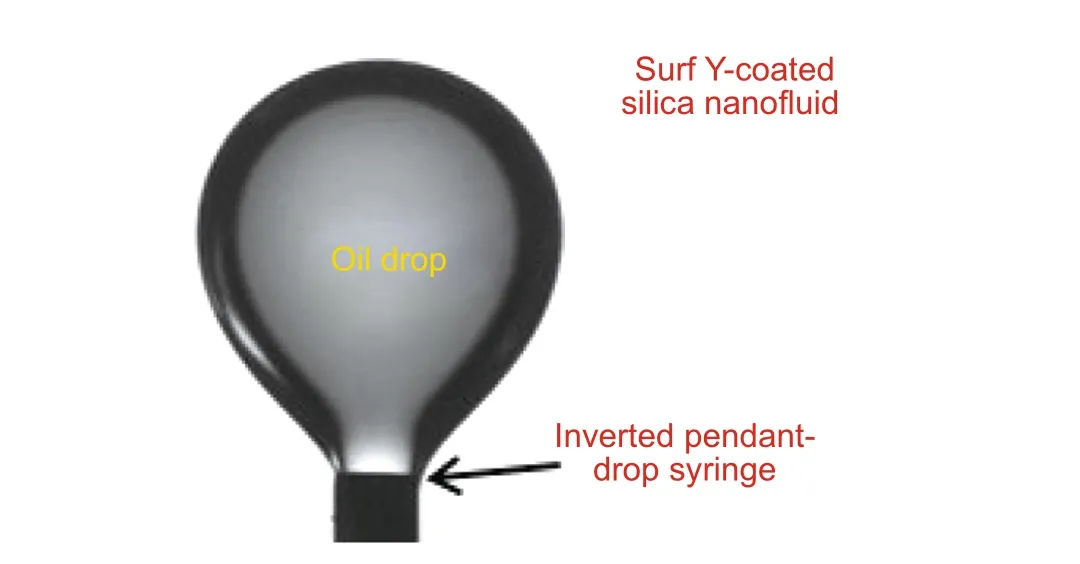
Fig. 9 A drop shape of studied crude oil obtained by the inverted pendant drop method (0.10 wt% Surf Y-coated silica nano fluid–surrounding fluid and crude oil)

Fig. 10 Effects of nanoparticle concentration and silica surface modification on interfacial tension at 25 °C
Figures 10, 11 and 12 show the IFT between nano fluids/crude oil at different temperatures before and after surface treatments. The IFT decreased from 17.10 mN/m (reference value) at 25 °C to a minimum of approximately 6 mN/m as the nanoparticles were introduced into the brine at 25 °C.The reason for a reduction in IFT may be due to the settling of nanoparticles at the oil and water interface (Farid Ibrahim and Nasr-el-Din 2018). However, for 0.05 wt% surfactanttreated nano fluids, the IFT decreased to 10.12 mN/m and 9 mN/m at 25 °C, respectively, in the case of Surf X- and Surf Y-coated nanoparticles. Additionally, it was noticed that the IFT reduced with an increase in the concentration of nanoparticles.
Moreover, as the temperature increased to 85 °C, the IFT decreased signi ficantly to 7.16 and 5.13 mN/m for 0.03 wt%Surf X- and Surf Y-coated silica nanofluids (Fig. 12).Declining IFT results in a reduction in capillary pressure that reveals better efficiency and oil recovery (Andreassen 2015).This causes the remaining oil saturation to be decreased, and the oil trapped by capillary pressure will be released due to a reduction in IFT (Ahmed et al. 2017a, b, 2018a, b).
Therefore, it can be reported that Surf Y-treated nanoparticles are proved to be more effective than the other untreated. Moreover, the Surf Y-treated silica nano fluid had the least IFT value of 5.13 mN/m as the temperature increased to 85 °C.
The results suggested that using 0.10 wt% surfactanttreated nano fluids the relatively stable IFTs, the lowest values are found between the temperature 25 and 85 °C that also consolidates the earlier research work done on EOR using nanoparticles. It has also been noticed that the interfacial tension should be as lowered as possible to make the injected fluid capable of enhancing residual oil recovery from porous media (Andreassen 2015; Ahmed et al. 2017a,b, 2018a, b).

Fig. 11 Effects of nanoparticle concentration and silica surface modification on interfacial tension at 50 °C
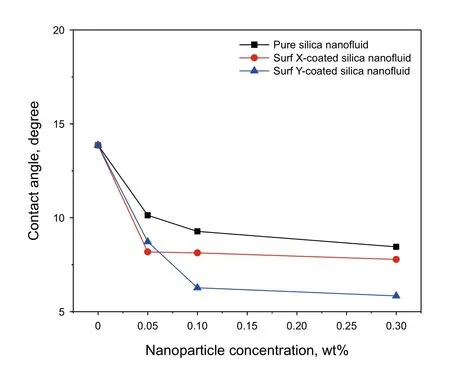
Fig. 12 Effects of nanoparticle concentration and silica surface modiif cation on interfacial tension at 85 °C
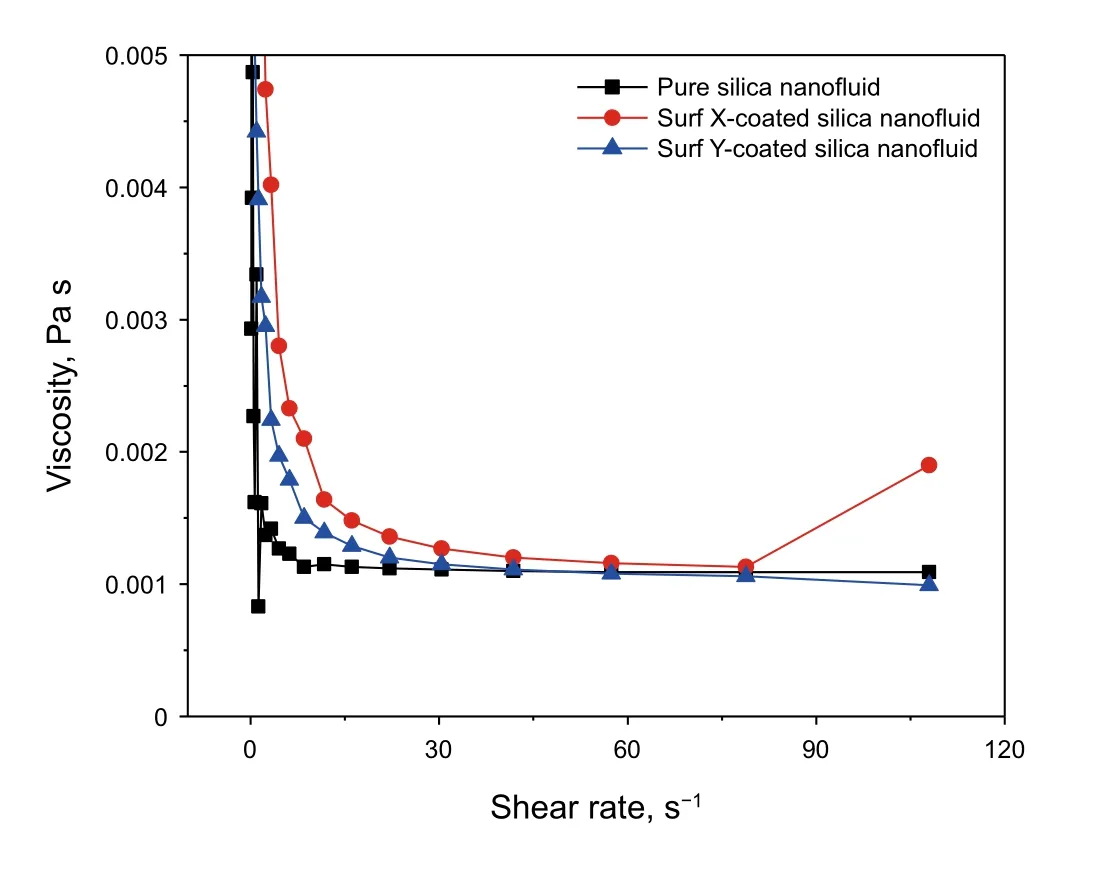
Fig. 13 Variation in viscosity with shear rate for pure, Surf X- and Surf Y-coated silica nano fluids
3.3 Rheological properties
Fluid rheology is a very critical parameter to be understood.The rheological properties of nano fluids were measured with an HPHT Modular Compact Rheometer (MCR 302) at ambient temperature with the help of DG 26.7 double-gap geometry. Before measurements, samples were set to equilibrate the temperature for approximately 10 min.
3.3.1 Variation in nano fluid viscosity with shear rate
The viscosities of 0.10 wt% (1000 ppm) nano fluids (pure silica nanoparticle solution, Surf X- and Surf Y-coated nanoparticle solutions) were measured at different shear rates (0–100 s−1), and the experimental results are shown in Fig. 13. It can be seen that for the same concentration,the Surf X-coated nano fluid has the highest viscosity followed by the Surf Y-coated nano fluid and then the pure silica nano fluid (valid under the shear rate of 30 s−1). A huge distinction is noticed in the viscosity values at low shear rates (< 30 s−1). At high shear rates (> 30 s−1), the nano fluid viscosity values are found to be lying close to each other. This behavior is due to the breaking of the aggregation network occurring when the shear forces overpass aggregation forces (Jamshidi et al. 2012; Rao 2010).
The viscosity of the Surf Y-coated silica nanofluid shows a plateau (> 30 s−1) after an exponential decrease(< 30 s−1). This behavior of the Surf Y-coated silica nanofluid makes it suitable for EOR applications to have stable displacement front. On the other hand, the viscosity of the Surf X-coated silica nano fluid increases after the shear rate higher than 85 s−1that may be due to aggregation of particles at high shear rates. This makes Surf X-coated silica nano fluid unsuitable for EOR applications. However,most of the nano fluids display shear-thinning that can also be seen in the surfactant-coated silica nano fluids. A reduction in viscosity is assumed to happen when the fluid is subjected to applied shearing in addition to higher applied stress, leading to a Bingham fluid that results in lowered viscosity (Ahmed et al. 2018a, b; Jamshidi et al. 2012).Shear-thinning makes the injected fluid non-Newtonian as the viscosity decreases with increasing shear strain,which makes the injected fluid more easily flow into water channeling or thief zones thus enhancing the oil recovery(Ahmed et al. 2017a, b, 2018a, b).
3.3.2 Variation in nano fluid viscosity with temperature
The effect of temperature on the viscosity of three nanofluids, pure, Surf X- and Surf Y-coated silica nanofluids was investigated. The experimental results shown in Fig. 14 reveal that the nano fluid viscosity reduces with an increase in temperature. The reason for this phenomenon is that increasing temperature may cause a decrease in the inter-particle/inter-molecular forces (Ahmed et al. 2016,2018a, b; Jamshidi et al. 2012). It can be seen that above a transition temperature around 64 °C, the viscosity of both surfactant-coated silica nano fluids (Surf X and Surf Y) increases sharply. This suggests that the nanoparticles formed a gel-type structure above 64 °C that might force the injected fluid to pass through the smaller pores that had been left un-swept in the case of displacement by the pure silica particle fluid. Moreover, initially at a constant shear rate of 10 s−1, the repulsive interaction among particles allows them to disperse in the fluid until the temperature reaches 64 °C.Furthermore, at high temperatures, the attractive interactions dominate thereby particles seem to form a gel-type structure and aggregate through hydrogen bonding and polymer entanglement, which are progressively disrupted under the in fluence of applied shear stress (Ahmed et al. 2016; Nguyen et al. 2007; Wang and Dong 2009).
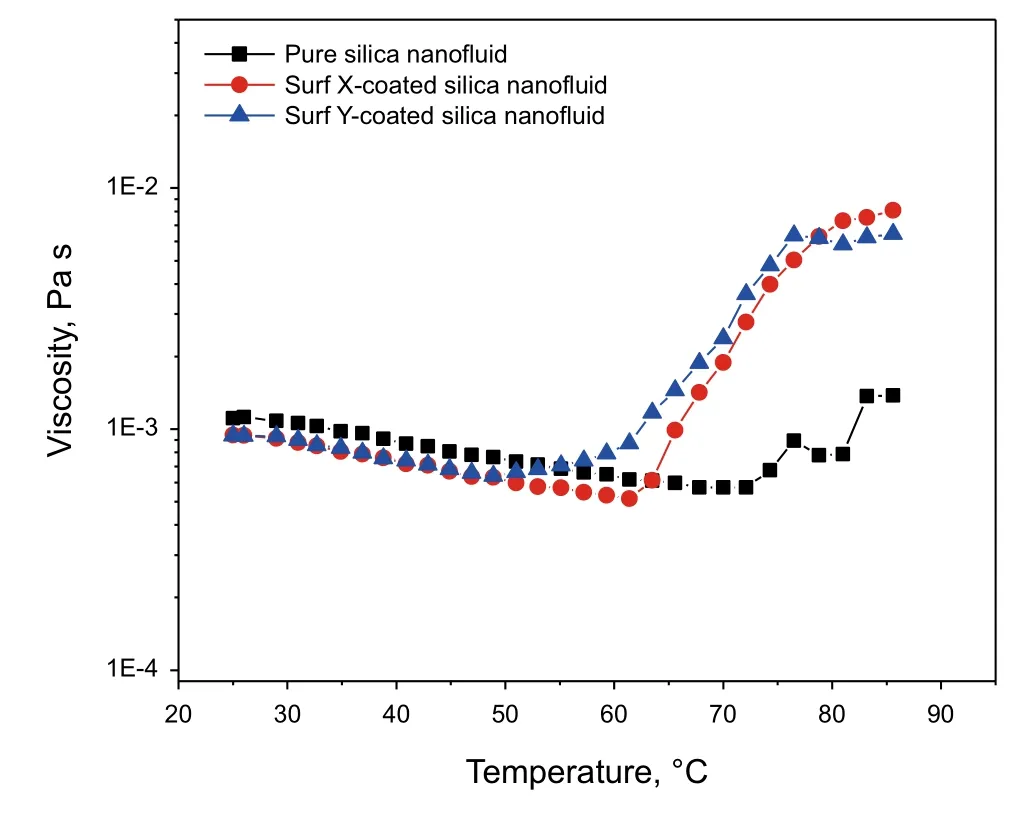
Fig. 14 Variation in viscosity with temperature for pure, Surf X and Surf Y-coated silica nano fluids at a shear rate of 10 s−1
3.4 Effect of surface‑modi fied nano fluid on oil recovery
The two-phase displacement experiments were carried out on Berea core plugs with the help of the FES-350 core- flood system. The core objective of these laboratory tests was to analyze the potential of surface-modi fied silica nanoparticle solutions (smart nano fluids) for enhancing oil recovery at the given reservoir conditions (119 °C and 2200 psi).
Figure 15 illustrates the differential pressure changes during the core- flooding runs of pure and surface-modi fied silica nano fluid floods. A slight increase in differential pressure across the core was observed at the breakthrough of 2 PV of 0.10 wt% nano fluids in both pure and surfactantcoated silica nano fluid floods. This increment could be a result of the increase in viscosity of nano fluids (Hou et al.2015) and the slight reduction in permeability due to nanoparticle entrapment in relatively bigger pore throats of waterchannels hence diverting the injected fluid flow toward unswept pore throats (Ahmed et al. 2017a, b).
The adsorption of nanoparticles caused an alteration of rock and fluid properties, i.e., wettability and IFT (Hou et al.2015; Myers 2005). Consequently, the ultimate oil recovery also signi ficantly increased by nano fluid injection. The experimental results (Table 2) show that after brine injection into Berea cores I and II, the primary oil recoveries were found to be 32.0% and 39.1%, respectively. The increases in the ultimate oil recoveries were 9.1% and 21.7%, respectively, for pure and surface-modi fied silica nano fluid floods.
Initially, the core is in water-wet condition, i.e., the surface of the rock is covered with water film and the existence of oil is in the globules. However, after the surfactant-coated silica nano fluid is injected into the core, the water film may become unstable because more silica nanoparticles along with surfactants coated on the particles tend to be adsorbed at the interface of rock and water compared to that at the interface of oil and water (Farid Ibrahim and Nasr-el-Din 2018; Ahmed et al. 2017a, b; Hou et al. 2015; Myers 2005).Consequently, this liquid film (water film and the existence of oil is in the globules) instability could lead to the formation of a mixed-wet state that is favorable for displacing oil through porous media (Farid Ibrahim and Nasr-el-Din 2018; Ahmed et al. 2017a, b; Salathiel 1973). An additional recovery of approximately 13% over the pure silica nanoparticles was achieved after the injection of Surf Y-coated silica nano fluid (see Table 2). This proves the potential of surface-modi fied nano fluids for enhancing oil recovery. The phenomena of a slight pressure build-up due to the injection of surface-modi fied silica nano fluid could be one of the main reasons for the increment of oil recovery. This phenomenon is named as log-jamming, which is a kind of temporary accumulation of nanoparticles and is bene ficial to improving the performance of nano fluid flooding (Franco-Aguirre et al. 2018; Skauge et al. 2010). This mechanism results in a pressure build-up in the pores, forcing the trapped oil out from the nearby pore throats. As the oil frees, the pressure around the surroundings drops back, and the plugging disappears gradually that causes the injected nano fluid to start flowing with water again. Furthermore, altering wettability and reducing IFT could be the major contributing factors in improving oil recovery but not limited to them only.

Fig. 15 Differential pressure changes during different core- flood runs. a Pure silica nano fluid. b Surf Y-coated silica nano fluid

Table 2 Comparison of oil recovery by pure and Surf Y-coated silica nano fluid floods
4 Conclusions
(1) In this paper, the rheological properties and IFT reduction in pure and surfactant-coated silica nano fluids were investigated. Two different internal ole fin sulfonates (IOS20–24and IOS19–23) were used to modify silica nanoparticles. The following main conclusions can be drawn on the basis of the experimental results:The surface-modi fied silica nanoparticles altered the rock wettability from weakly water-wet toward more water-wet, which was evidenced by the reduction in the contact angle from 80° to the least values of 3°–2°.
(2) The addition of 0.30 wt% surface-modi fied silica nanofluid lowered the oil/water IFT as the temperature rises,which is bene ficial to EOR.
(3) The surface-modi fied silica nanoparticles could alter the rheological properties of fluids due to as the stability of the coated silica nanoparticles that has been observed by their shear-thinning behavior. This behavior makes the injected fluid non-Newtonian as the nano fluid viscosity decreases with increasing shear strain. This is conducive to the injected fluid flowing into water channeling or thief zones and then the enhanced oil recovery.
(4) Both the pure and surface-modi fied silica nano fluids could enhance the ultimate oil recovery from sandstone cores by about 9.1% and 21.7% of the original oil in place, respectively.
Open AccessThis article is distributed under the terms of the Creative Commons Attribution 4.0 International License (http://creat iveco mmons.org/licen ses/by/4.0/), which permits unrestricted use, distribution, and reproduction in any medium, provided you give appropriate credit to the original author(s) and the source, provide a link to the Creative Commons license, and indicate if changes were made.
- 石油科学通报的其它文章
- Thermal maturity evaluation using Raman spectroscopy for oil shale samples of USA: comparisons with vitrinite re flectance and pyrolysis methods
- Light hydrocarbon geochemistry: insight into oils/condensatesfamilies and inferred source rocks of the Woodford–Mississippian tight oil play in North‑Central Oklahoma, USA
- Deep‑water depositional architecture and sedimentary evolution in the Rakhine Basin, northeast Bay of Bengal
- A two‑step method to apply Xu–Payne multi‑porosity model to estimate pore type from seismic data for carbonate reservoirs
- Nonlinear amplitude versus angle inversion for transversely isotropic media with vertical symmetry axis using new weak anisotropy approximation equations
- Numerical simulation and dimension reduction analysis of electromagnetic logging while drilling of horizontal wells in complex structures

